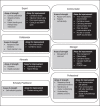Clinical Instructors' Perceptions of Internationally Educated Physical Therapists' Readiness to Practise during Supervised Clinical Internships in a Bridging Programme
- PMID: 34456432
- PMCID: PMC8370728
- DOI: 10.3138/ptc-2019-0067
Clinical Instructors' Perceptions of Internationally Educated Physical Therapists' Readiness to Practise during Supervised Clinical Internships in a Bridging Programme
Abstract
Purpose: The purpose of this study was to describe clinical instructors' (CIs) comments on the Canadian Physiotherapy Assessment of Clinical Performance (ACP) that reflect areas of strength and areas requiring improvement among internationally educated physical therapists (IEPTs) during supervised clinical internships in a bridging programme. Method: We reviewed the assessment records of 100 IEPTs' clinical performance during two internships each for three successive cohorts of learners in a Canadian bridging programme. We extracted the CIs' text from 385 comment sections of the ACP completed during these internships and analyzed them using qualitative content analysis. Results: The iterative deductive coding process resulted in 36 subcategories: 14 for areas of strength and 22 for areas requiring improvement. We merged the 36 subcategories to produce nine categories: four areas of strength (subjective assessment, treatment, patient confidentiality, and professionalism) and five areas for improvement (objective assessment, clinical reasoning, establishment of treatment goals, communication, confidence, and time management). We then grouped these categories into two broad themes: professional practice and professional conduct. Conclusions: The CIs commended the IEPTs for their clinical competence in subjective assessment, treatment, patient confidentiality, and professionalism. The areas requiring improvement typically required more complex clinical decision-making skills, which may have been challenging for these IEPTs to demonstrate as competently during a short internship.
Objectif : décrire les commentaires des moniteurs cliniques (MC) dans l’évaluation clinique de la performance (ÉCP) en physiothérapie au Canada, qui reflètent les points forts et les points à améliorer chez les physiothérapeutes formés à l’étranger (PTFÉ) pendant les stages cliniques supervisés d’un programme de transition. Méthodologie : les chercheurs ont analysé les dossiers d’évaluation de la performance clinique de 100 PTFÉ faisant partie de trois cohortes successives d’un programme de transition canadien, qui ont toutes participé à deux stages. Ils ont extrait les textes de 385 sections de commentaires des MC dans l’ÉCP remplie lors de ces stages et ont procédé à une analyse qualitative du contenu. Résultats : le processus itératif de codage déductif s’est traduit par 36 sous-catégories : 14 dans les points forts et 22 dans les points à améliorer. Les chercheurs ont fusionné les 36 sous-catégories en neuf points : quatre points forts (évaluation subjective, traitement, confidentialité des patients et professionnalisme) et cinq points à améliorer (évaluation objective, raisonnement clinique, établissement des objectifs thérapeutiques, communication, confiance et gestion du temps). Ils ont ensuite regroupé ces catégories en deux grands thèmes : pratique professionnelle et conduite professionnelle. Conclusion : Les MC ont félicité les PTFÉ pour leur compétence clinique dans l’évaluation subjective, le traitement, la confidentialité des patients et le professionnalisme. Les points à améliorer exigent habituellement des aptitudes décisionnelles cliniques plus complexes, à l’égard desquelles les PTFÉ ont peut-être eu plus de difficulté à démontrer leur compétence dans le cadre d’un court stage.
Keywords: clinical clerkship; clinical competence; clinical skills; foreign-trained medical graduates.
© Canadian Physiotherapy Association.
Figures
Similar articles
-
Therapists to Therapy Assistants: Experiences of Internationally Educated Physiotherapists and Occupational Therapists.Can J Occup Ther. 2025 Mar;92(1):18-28. doi: 10.1177/00084174241255467. Epub 2024 May 27. Can J Occup Ther. 2025. PMID: 38803166 Free PMC article.
-
Clinical Instructors' Perspectives on the Clinical Education of Internationally Educated Physical Therapists: Diversity's Impact on the Experience.Physiother Can. 2018;70(1):72-80. doi: 10.3138/ptc.2016-92.e. Physiother Can. 2018. PMID: 29434421 Free PMC article.
-
Clinical Performance Scores of Internationally Educated Physical Therapists during Clinical Education in a Bridging Programme.Physiother Can. 2019 Summer;71(3):271-284. doi: 10.3138/ptc.2018-10.e. Physiother Can. 2019. PMID: 31719723 Free PMC article.
-
An Innovative Program to Support Internationally Educated Health Professionals and Their Instructors: Role of the Clinical Practice Facilitator.J Contin Educ Health Prof. 2016 Fall;36(4):269-277. doi: 10.1097/CEH.0000000000000115. J Contin Educ Health Prof. 2016. PMID: 28350308
-
Nursing instructors' clinical education competencies: An integrated review.J Pak Med Assoc. 2021 May;71(5):1458-1466. doi: 10.47391/JPMA.089. J Pak Med Assoc. 2021. PMID: 34091635 Review.
Cited by
-
Therapists to Therapy Assistants: Experiences of Internationally Educated Physiotherapists and Occupational Therapists.Can J Occup Ther. 2025 Mar;92(1):18-28. doi: 10.1177/00084174241255467. Epub 2024 May 27. Can J Occup Ther. 2025. PMID: 38803166 Free PMC article.
-
Clinician's Commentary on Kalu et al.Physiother Can. 2021 Spring;73(2):204-205. doi: 10.3138/ptc-2019-0067-cc. Physiother Can. 2021. PMID: 34456433 Free PMC article. No abstract available.
References
-
- Austin Z, Dean M. Bridging education for foreign trained professionals: the International Pharmacy Graduate (IPG) Program in Canada. Teach Higher Educ. 2006;11(1):19–32. 10.1080/13562510500400081. - DOI
-
- Neiterman E, Bourgeault I, Peters J, et al. Best practices in bridging education: multiple case study evaluation of postsecondary bridging programs for internationally educated health professionals. J Allied Health. 2018;47(1):e23–e28. Medline:29504027 - PubMed
LinkOut - more resources
Full Text Sources



